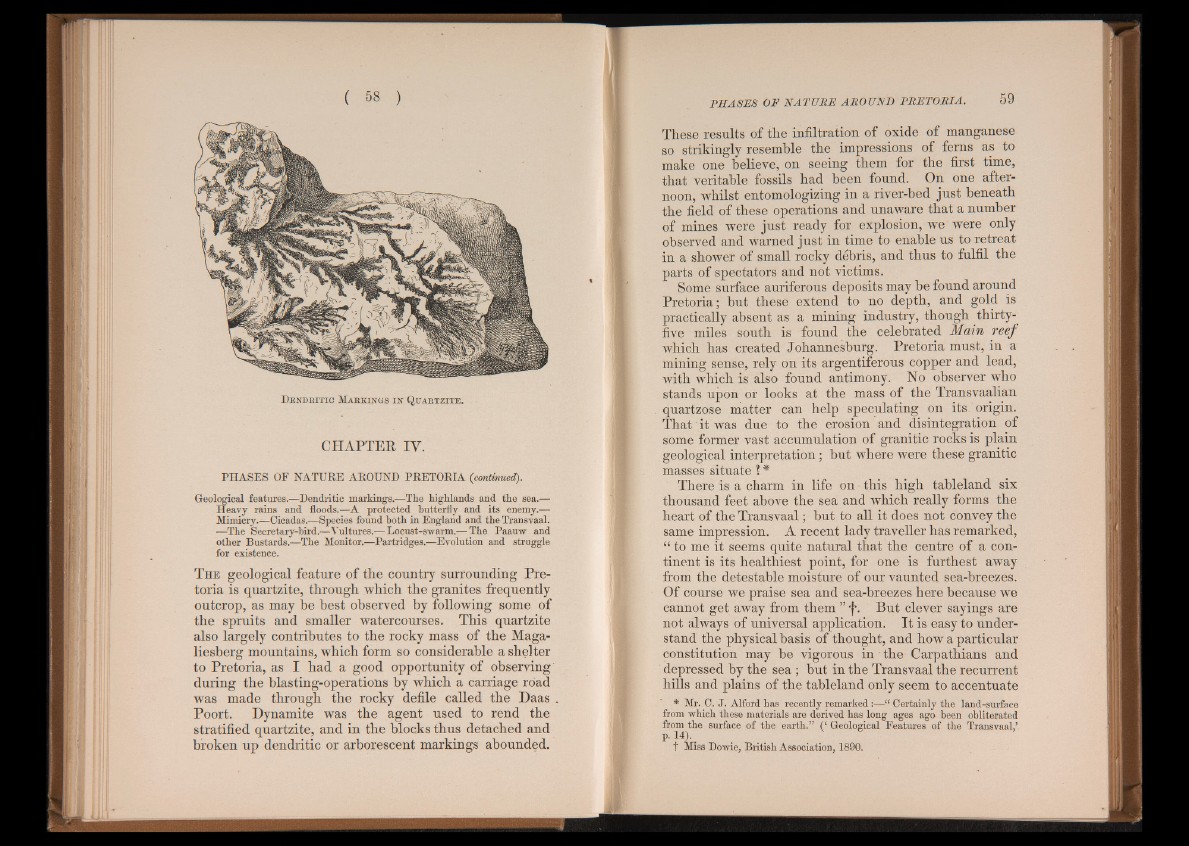
Dendbitic Ma sk in g s in Qu abtzite.
CHAPTER IV.
PHASES OF NATURE AROUND PRETORIA (continued).
Geological features.—Dendritic markings.—The highlands and the sea.—
Heavy rains and floods.—A protected butterfly and its enemy.—
Mimicry.^Cicadas.—Species found both in England and the Transvaal.
*—The Secretary-bird.—Vultures.— Locust-swarm.— The Paauw and
other Bustards.—The Monitor.—Partridges.—Evolution and struggle
for existence.
The geological feature of the country surrounding Pretoria
is quartzite, through which the granites frequently
outcrop, as may he best observed by following some of
the spruits and smaller watercourses. This quartzite
also largely contributes to the rocky mass of the Maga-
liesberg mountains, which form so considerable a shelter
to Pretoria, as I had a good opportunity of observing
during the blasting-operations by which a carriage road
was made through the rocky defile called the Daas
Poort. Dynamite was the agent used to rend the
stratified quartzite, and in the blocks thus detached and
broken up dendritic or arborescent markings abounded.
These results of the infiltration of oxide of manganese
so strikingly resemble the impressions of ferns as to
make one believe, on seeing them for the first time,
that veritable fossils had been found. On one afternoon,
whilst entomologizing in a river-bed just beneath
the field of these operations and unaware that a number
of mines were just ready for explosion, we were only
observed and warned just in time to enable us to retreat
in a shower of small rocky debris, and thus to fulfil the
parts of spectators and not victims.
Some surface auriferous deposits may be found around
Pretoria; but these extend to no depth, and gold is
practically absent as a mining industry, though thirty-
five miles south is found the celebrated Main reef
which has created Johannesburg. Pretoria must, in a
mining sense, rely on its argentiferous copper and lead,
with which is also found antimony. No observer who
stands upon or looks at the mass of the Transvaalian
quartzose matter can help speculating on its origin.
That it was due to the erosion and disintegration of
some former vast accumulation of granitic rocks is plain
geological interpretation; but where were these granitic
masses situate % *
There is a charm in life on this high tableland six
thousand feet above the sea and which really forms the
heart of the Transvaal; but to all it does not convey the
same impression. A recent lady traveller has remarked,
“ to me it seems quite natural that the centre of a continent
is its healthiest point, for one is furthest away
from the detestable moisture of our vaunted sea-breezes.
Of course we praise sea and sea-breezes here because we
cannot get away from them ” j*. But clever sayings are
not always of universal application. It is easy to understand
the physical basis of thought, and how a particular
constitution may be vigorous in the Carpathians and
depressed by the sea ; but in the Transvaal the recurrent
hills and plains of the tableland only seem to accentuate
* Mr. C. J. Alford has recently remarked:—“ Certainly the land-surface
from which these materials are derived has long ages ago been obliterated
from the surface of the earth.” (‘ Geological Features of the Transvaal,’
p-14h. t Miss Dowie, British Association, 1890.